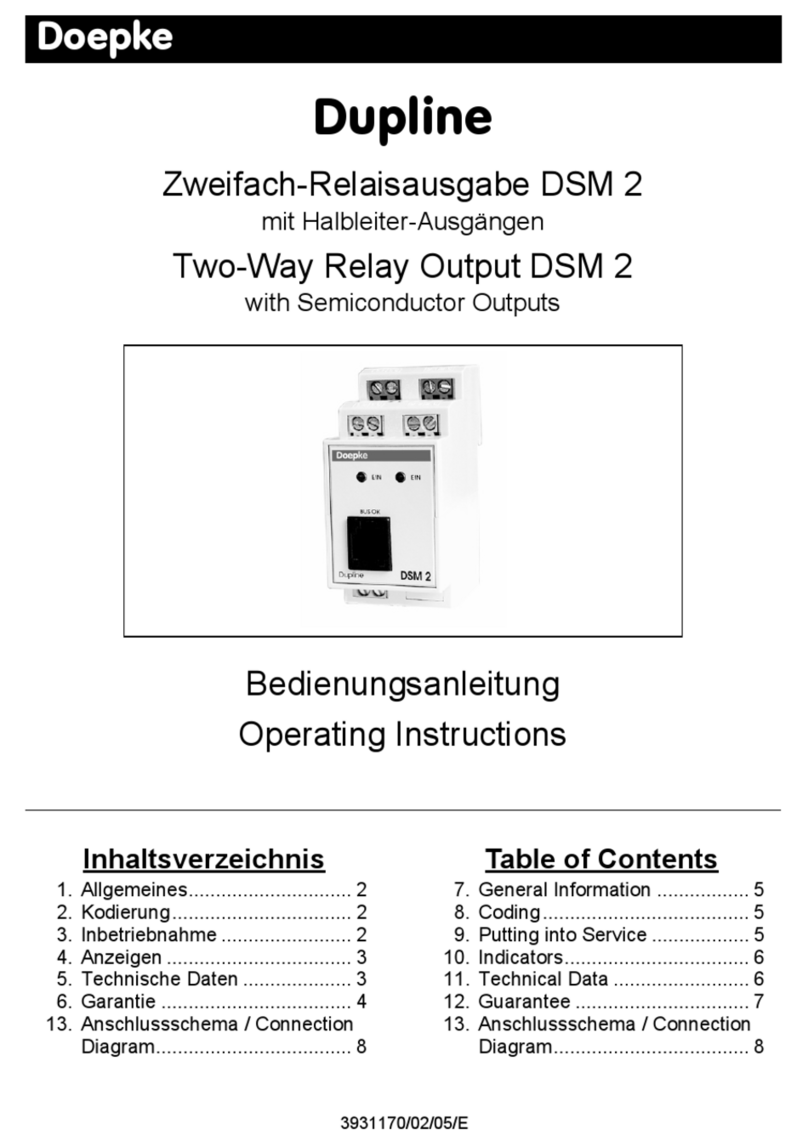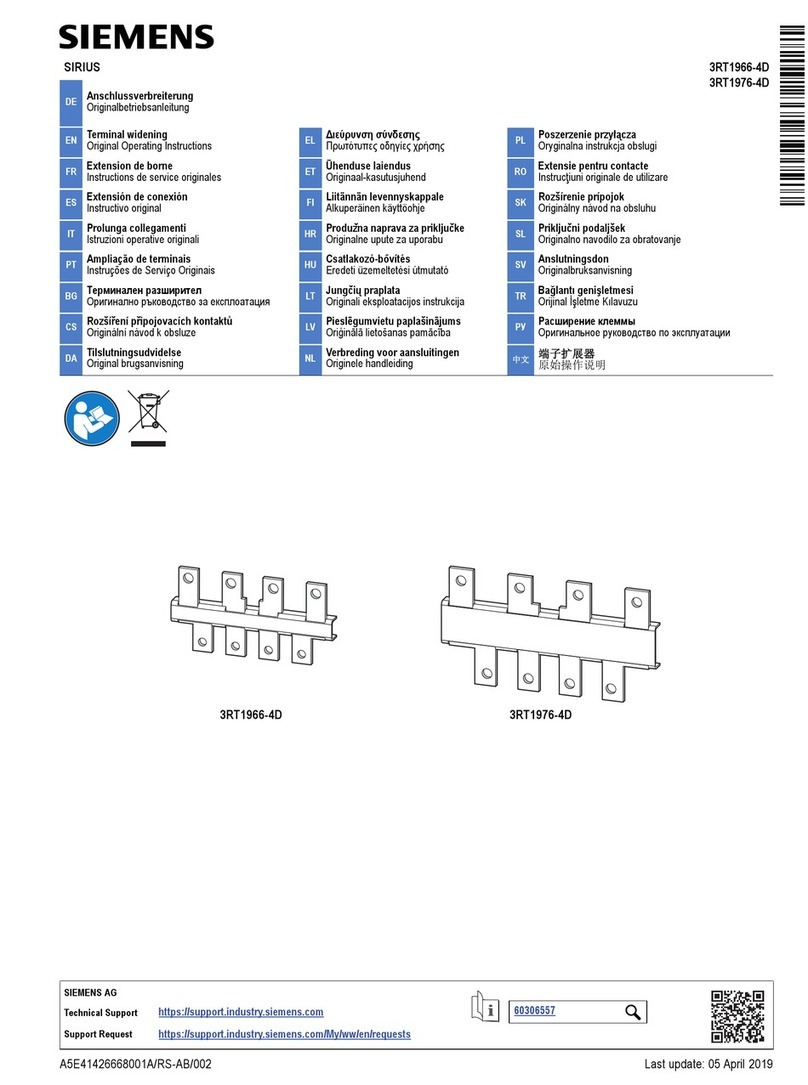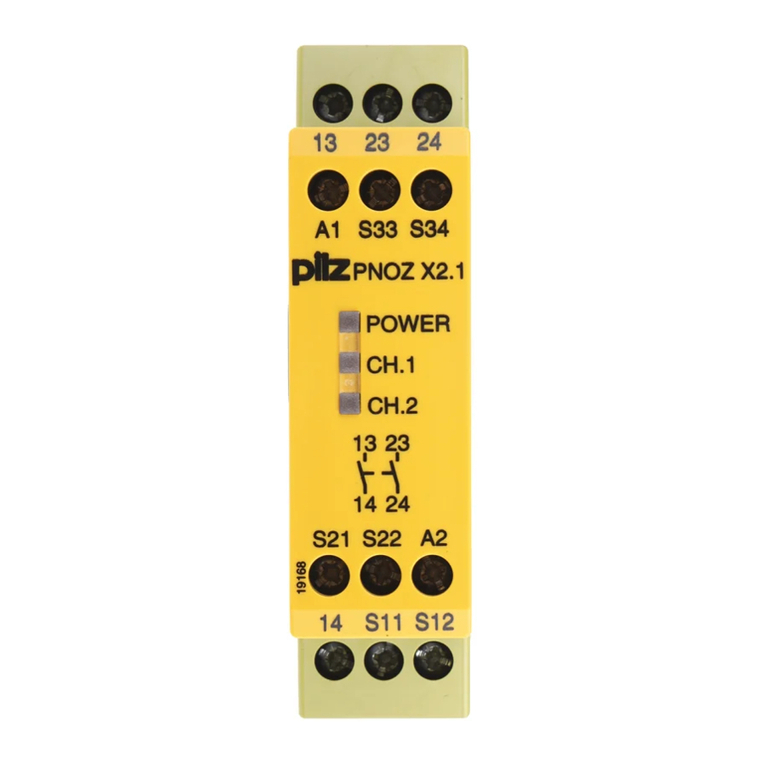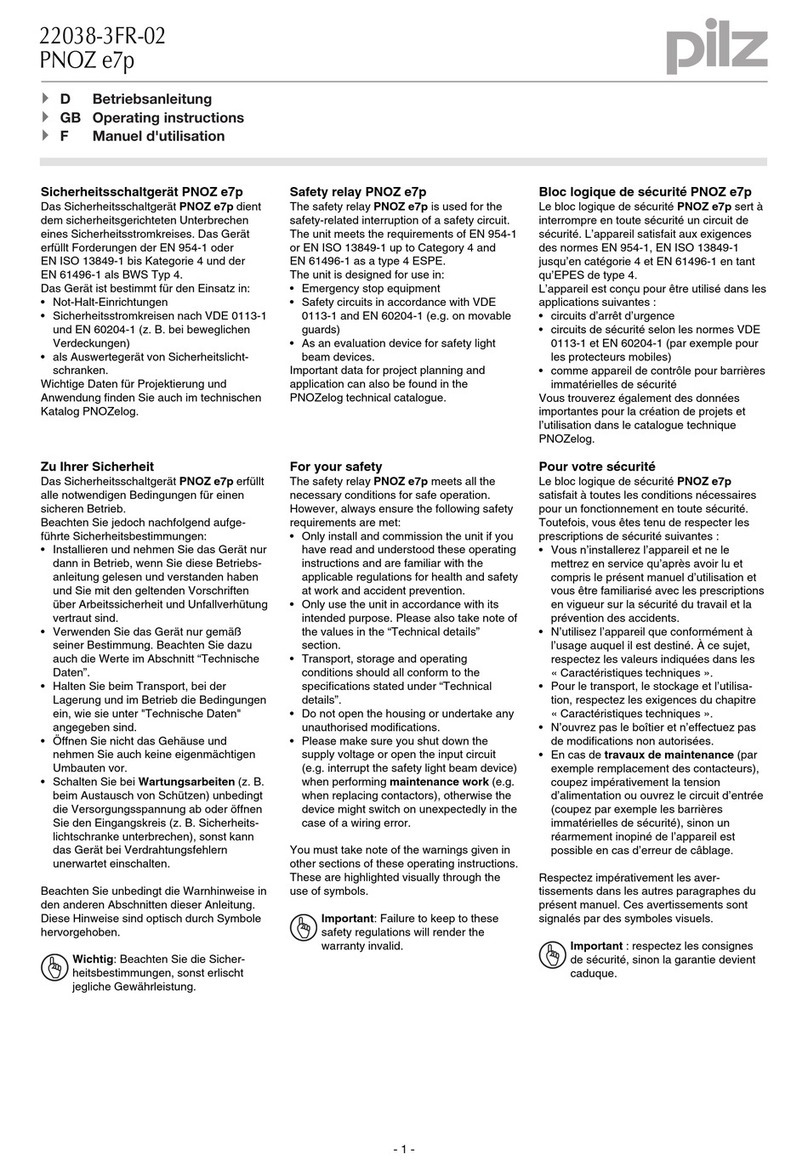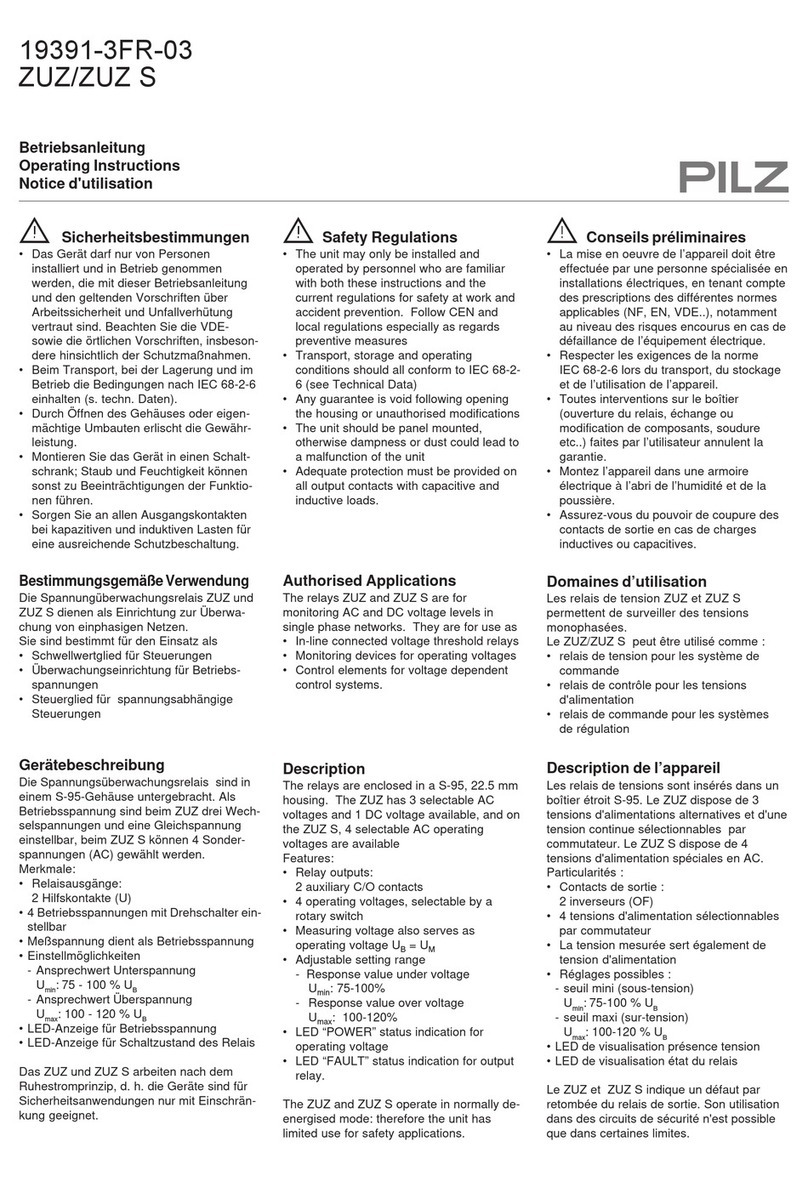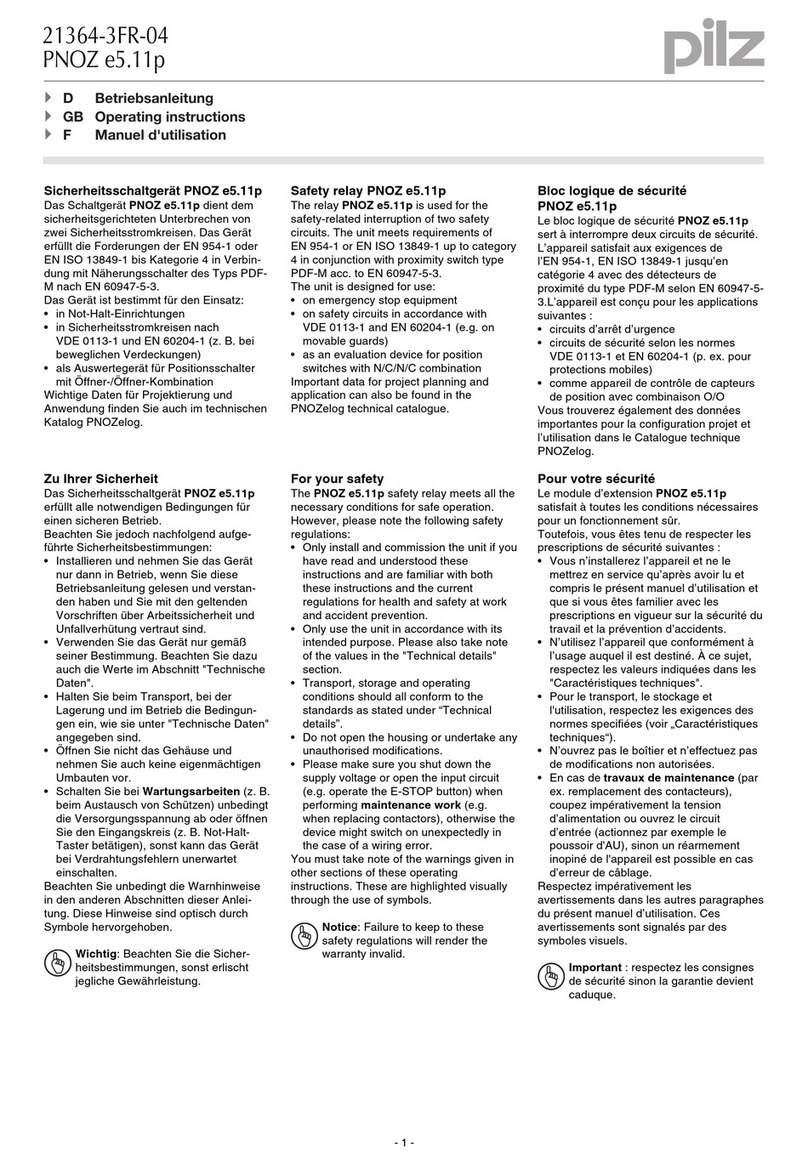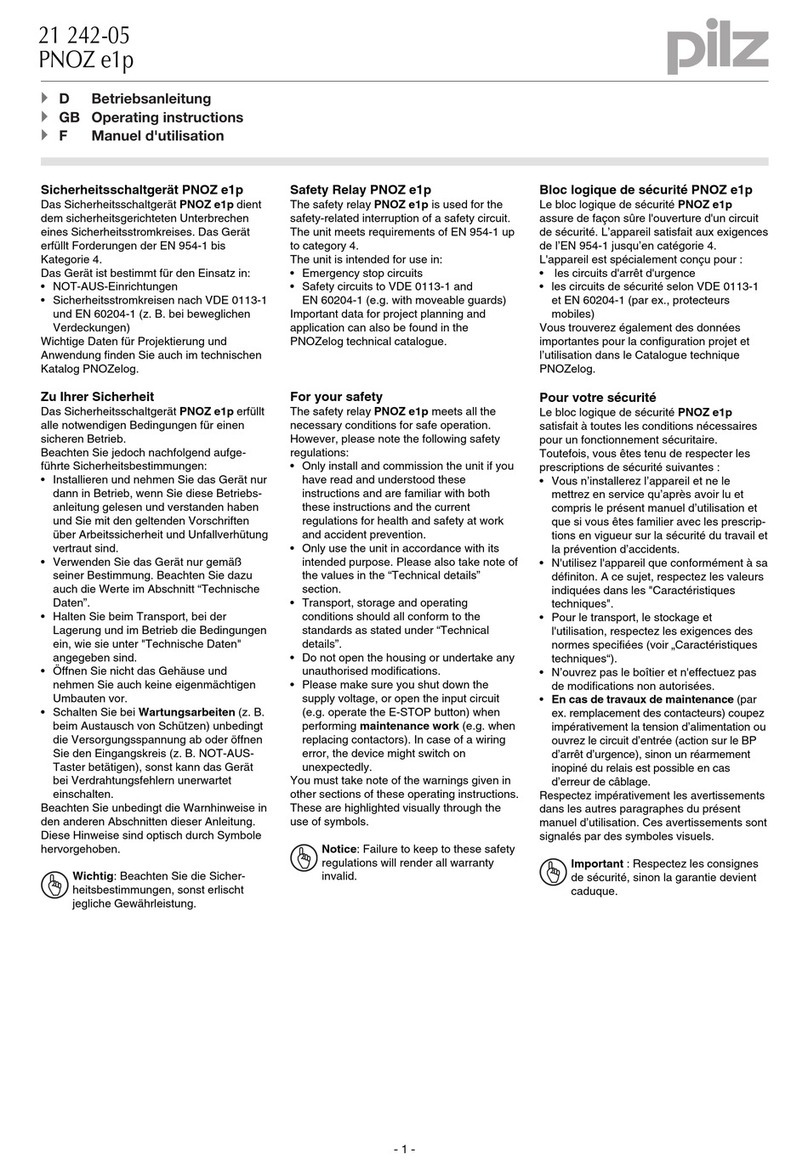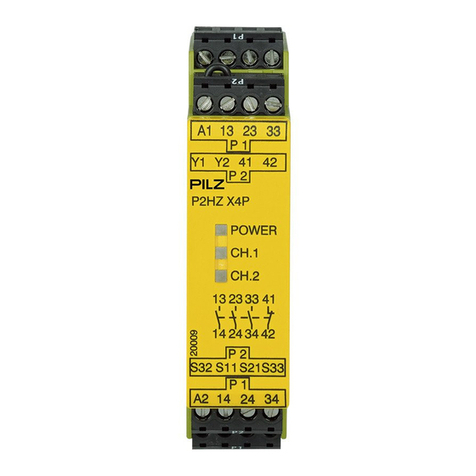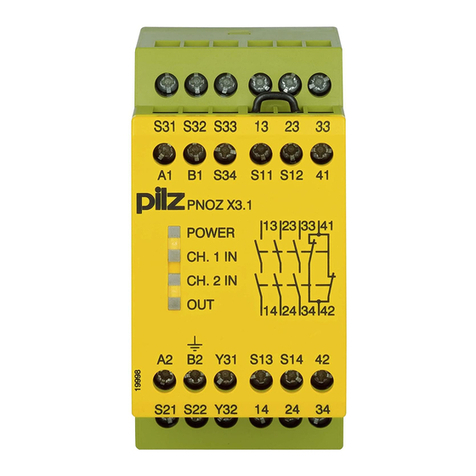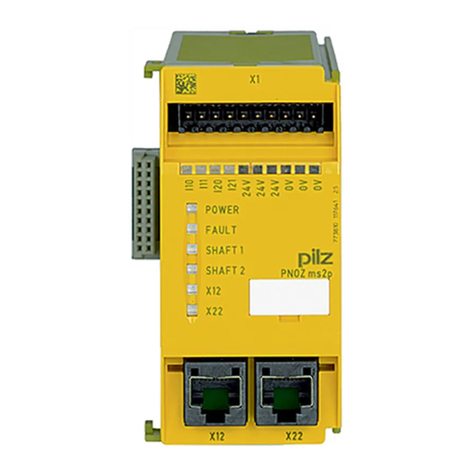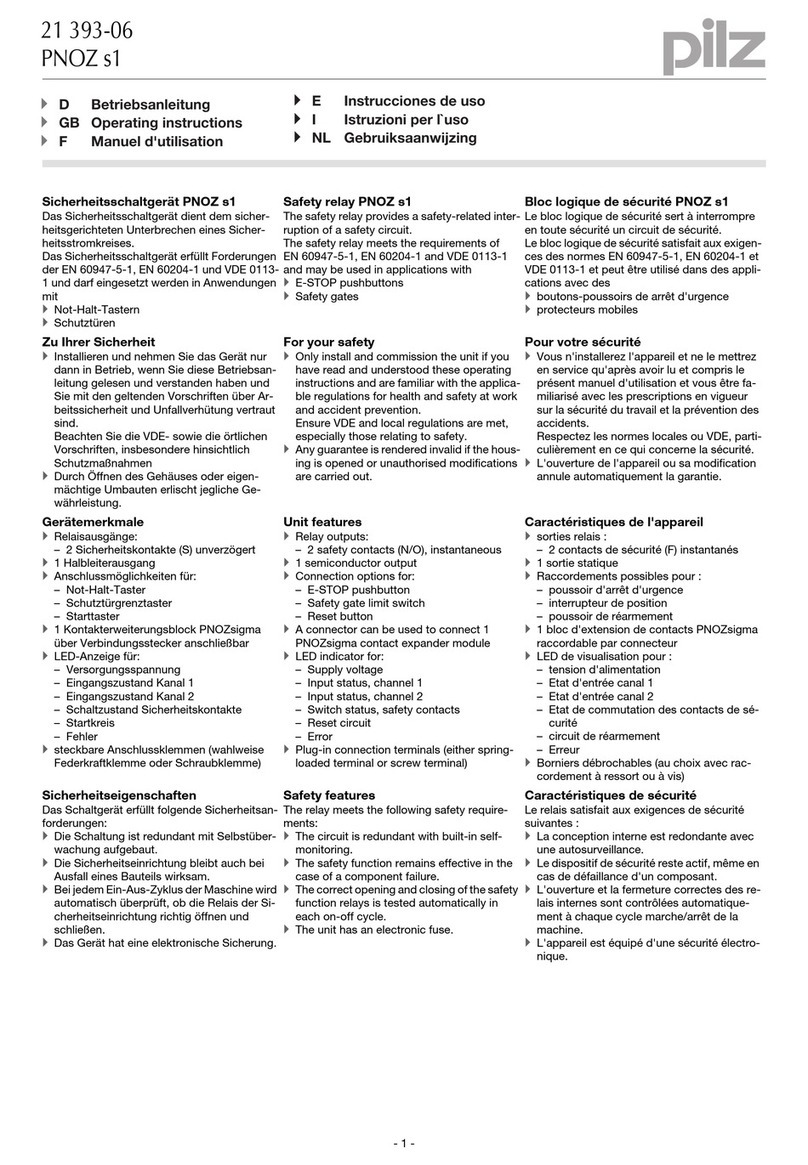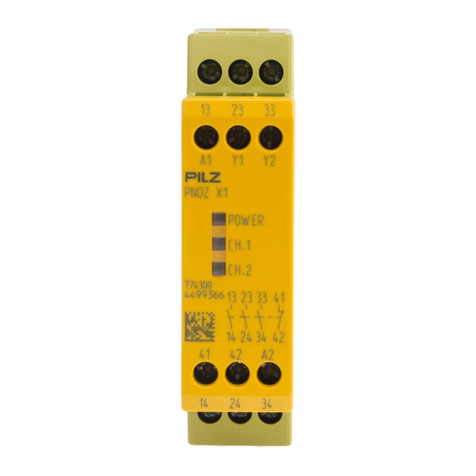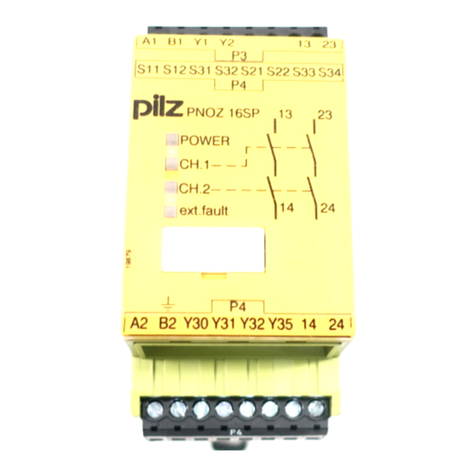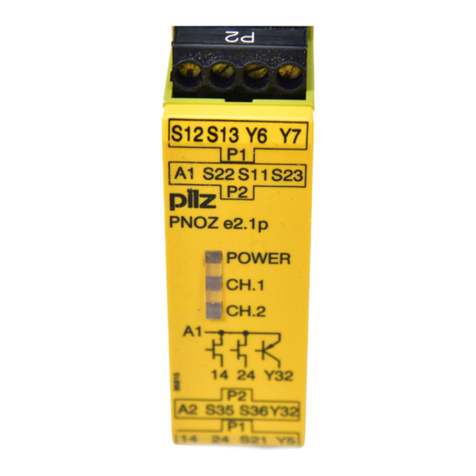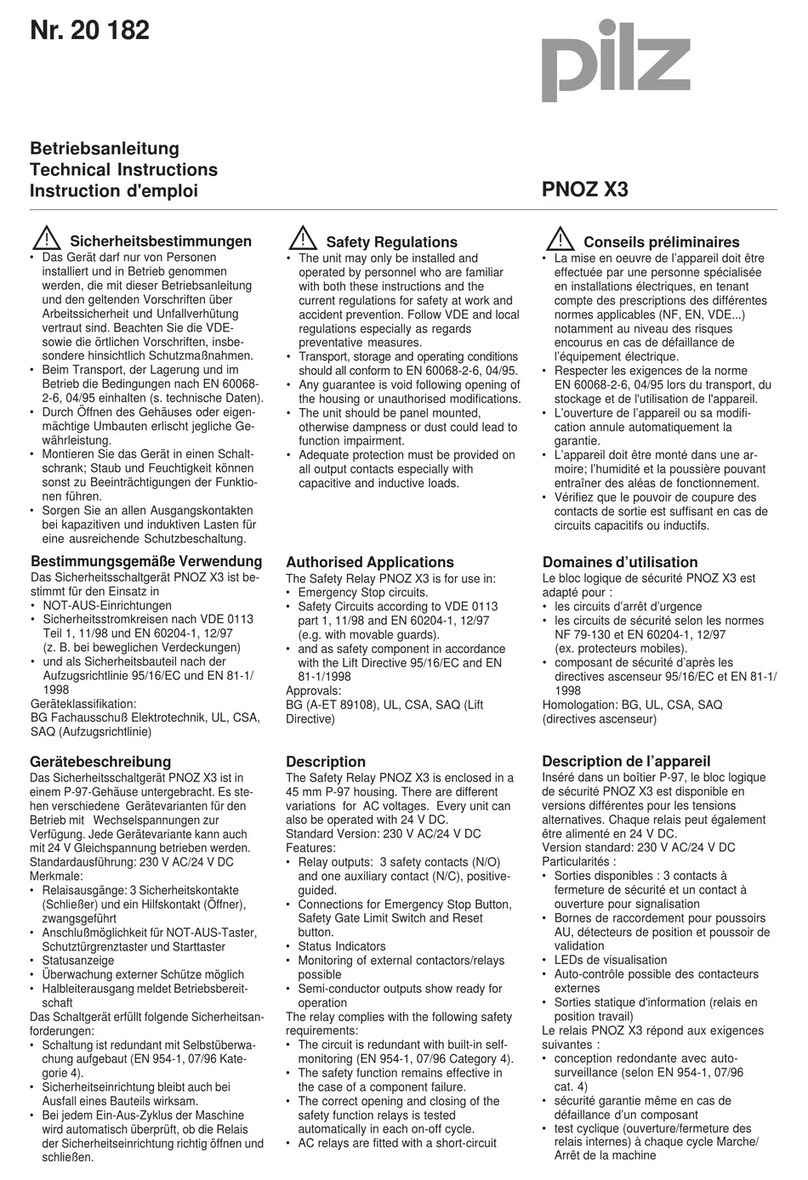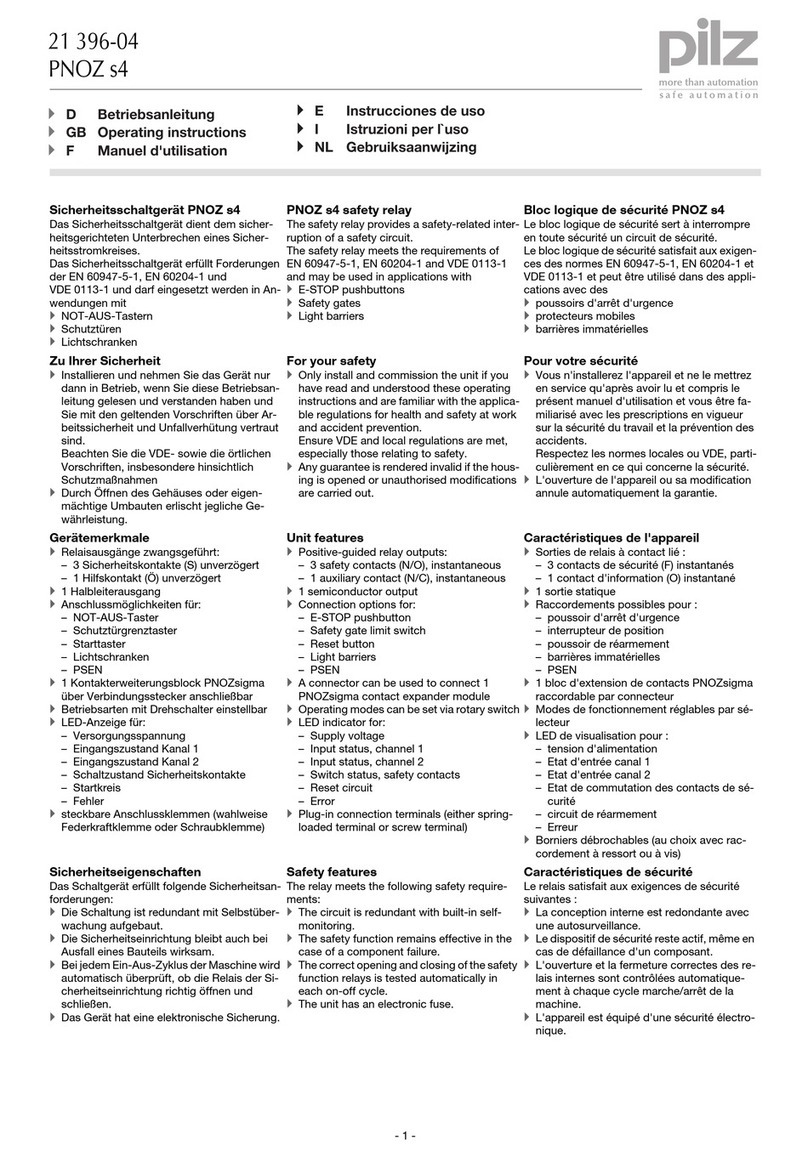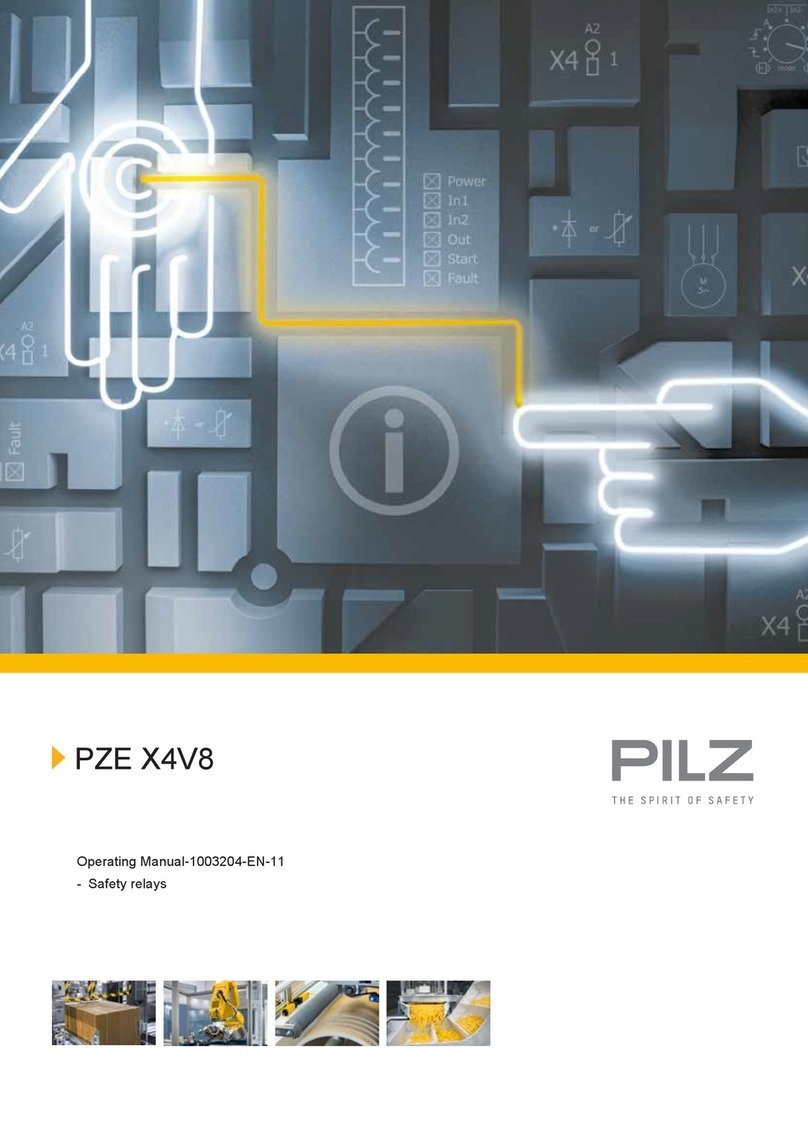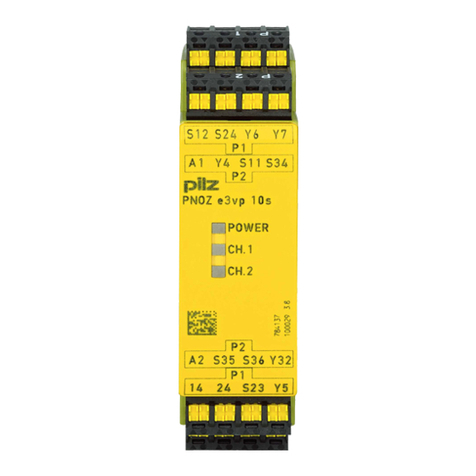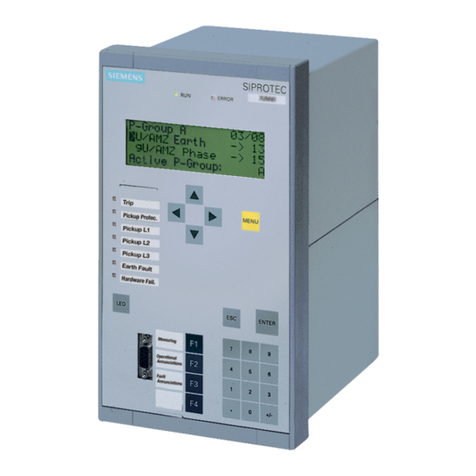
- 2 -
Gerätemerkmale
• Ausgänge in Halbleitertechnik:
2 Sicherheitsausgänge, 1 Hilfsausgang
und 2 Taktausgänge
• Relaisausgänge: 4 Sicherheitskontakte
(S), zwangsgeführt
• sichere Trennung der Sicherheitskontakte
33-34, 43-44 und 53-54 vom Steuerstrom-
kreis und der Versorgungsspannung
• Anschlussmöglichkeit für Not-Halt-Taster,
Schutztürgrenztaster, Starttaster, Schalt-
matten und Schaltleisten der Fa. Haake,
Auswertegeräte von Näherungsschaltern
• Verarbeitung von Signalen aus Aus-
gangsschalteinrichtungen von Schalt-
matten oder aus Ausgangsschalt-
elementen von Lichtschranken
• Rückfallverzögerung einstellbar
• Hilfsausgang umschaltbar als Diagnose-
ausgang
• UND- und ODER-Eingang zur logischen
Verknüpfung mehrerer Geräte
• Querschlussüberwachung durch Takt-
ausgänge
• Statusanzeige
• Rückführkreis zur Überwachung externer
Schütze
Funktionsbeschreibung
Arbeitsweise
Zwei Mikro-Controller werten die Eingangs-
kreise aus und schalten abhängig davon die
Ausgänge. Die Mikro-Controller überwachen
sich gegenseitig.
Zustand der Ausgänge
• Eingangskreis geschlossen (z. B. Not-Halt-
Taster nicht betätigt).
Die Sicherheitsausgänge 14 und 24
(verzögert) und der Hilfsausgang Y32
leiten. Die Sicherheitskontakte 33-34, 43-
44, 53-54 und 63-64 sind geschlossen.
• Eingangskreis wird geöffnet (z. B. Not-
Halt-Taster betätigt).
Die Sicherheitsausgänge 14 und 24
(verzögert) und der Hilfsausgang Y32 sind
gesperrt. Die Sicherheitskontakte 33-34,
43-44, 53-54 und 63-64 sind geöffnet.
Funktionen
• Wenn an den Eingang Y5 für mindestens
250 ms ein High-Signal (+24 V DC) gelegt
wird, wechselt der Ausgang Y32 in die
Diagnosefunktion. Die Ansteuerung
erfolgt über einen Treiber, der als Zubehör
zur Verfügung steht oder selbst erstellt
werden kann. Wenn der Eingang Y5 offen
oder Low ist, funktioniert Y32 wie ein
Hilfsausgang.
• Zur logischen Verknüpfung mehrerer
Geräte besitzt das PNOZ e6vp einen
UND- und einen ODER-Eingang. Die
Eingänge weisen Schaltverzögerungen
auf, die sich im Falle einer UND-Verknüp-
fung addieren.
• Der Sicherheitsausgang 24 ist rück-
fallverzögert. Wird nur die ODER-
Funktion verwendet, kann der
Sicherheitsausgang 14 ebenfalls
rückfallverzögert werden. Die Sicherheits-
kontakte 33-34, 43-44, 53-54 und 63-64
schalten entsprechend dem Sicherheits-
ausgang 14 wahlweise unverzögert oder
verzögert. Die Rückfallzeit ist einstellbar.
• Im Fehlerfall kann sich die Rückfall-
verzögerung verkürzen.
Unit features
• Outputs use semiconductor technology:
2 safety outputs, 1 auxiliary output and
2 test pulse outputs
• Relay outputs: 4 safety contacts (N/O),
positive-guided
• Safe isolation of the safety contacts 33-34,
43-44 and 53-54 from the control circuit
and the supply voltage
• Connection for E-STOP button, safety gate
limit switch, reset button, safety mats and
connecting blocks made by Haake,
evaluation devices for proximity switches
• Processes signals from output switching
elements on safety mats or light barriers
• Delay-on de-energisation can be set
• Auxiliary output can be used as a
diagnostic output
• AND/OR input for logic links between
several units
• Test pulse outputs monitor shorts across
the input contacts
• Status display
• Feedback loop for monitoring external
contactors
Caractéristiques de l’appareil :
• Sorties statiques :
2 sorties de sécurité, 1 sortie d'information
et 2 sorties impulsionnelles
• Sorties de relais : 4 contacts de sécurité
(F), à contacts liés
• séparation galvanique des contacts de
sécurité 33-34, 43-44 und 53-54 du circuit
de commande et de la tension
d'alimentation
• Possibilités de raccordement de boutons
d'arrêt d'urgence, d'interrupteurs de
position, de poussoir de validation, de
tapis et bords sensibles de la Sté Haake,
d' unités de contrôle de détecteurs
inductifs
• Traitement des signaux de sortie d'unités
de contrôle de tapis sensibles et de
barrières lumineuses
• Temporisation à la retombée réglable
• Sortie d'information commutable en sortie
de diagnostic
• Entrées ET et OU pour le couplage
logique de plusieurs appareils
• Surveillance des courts-circuits par sorties
impulsionnelles
• Affichage de l’état
• Boucle de retour pour le contrôle des
contacteurs externes
Descriptif du fonctionnement
Fonctionnement
Deux micro-processeurs analysent les
circuits d'entrée et pilotent en conséquence
les sorties. Les micro-processseurs se
contrôlent mutuellement.
Etat des sorties
• Circuit d’entrée fermé (par exemple le
poussoir d’AU n’a pas été activé)
Mise sous tension des sorties de sécurité
14 et 24 (temporisée) et de la sortie
d'information Y32. Les contacts de
sécurité 33-34, 43-44, 53-54 et 63-64 sont
fermés.
• Circuit d’entrée ouvert (par exemple le
poussoir d’AU a été activé).
Blocage des sorties de sécurité 14 et 24
(temporisée) et de la sortie d'information
Y32. Les contacts de sécurité 33-34, 43-
44, 53-54 et 63-64 sont ouverts.
Fonctions
• Si un signal Haut (+24 V CC) est appliqué
sur l’entrée Y5 pendant au moins 250 ms,
la sortie Y32 commute en sortie
diagnostic. Son exploitation est réalisée
via un protocole disponible en tant
qu'accessoire ou développé par
l'utilisateur. Si l’entrée Y5 est ouverte ou
Bas, Y32 fonctionne comme une sortie
d'information.
• Pour le couplage logique de plusieurs
appareils, le PNOZ e6vp possède une
entrée ET et et une entrée OU. Les
entrées ont une temporisation de couplage
qui est cumulative dans le cas d’une
liaison ET.
• La sortie de sécurité 24 est une sortie
temporisée à la retombée. Dans le cas
où seule la fonction OU est utilisée, la
sortie de sécurité 14 peut elle aussi être
temporisée en retombée. Les contacts de
sécurité 33-34, 43-44, 53-54 et 63-64
commutent avec ou sans temporisation,
correspondant à la sortie de sécurité 14.
Le temps de retombée est réglable.
• En cas de défaut, une diminution de la
temporisation à la retombée est possible.
Function
Operation
Two microcontrollers evaluate the input
circuits and switch the outputs accordingly.
The microcontrollers monitor each other.
Output status
• Input circuit closed (e.g. E-STOP button is
not operated)
Safety outputs 14 and 24 (delayed) and
auxiliary output Y32 are energised. The
safety contacts 33-34, 43-44, 53-54 and
63-64 are closed.
• Input circuit is open (e.g. E-STOP button is
operated).
Safety outputs 14 and 24 (delayed) and
auxiliary output Y32 are de-energised. The
safety contacts 33-34, 43-44, 53-54 and
63-64 are open.
Functions
• If there is a high signal (+24 VDC) at input
Y5 for at least 250 ms, output Y32
switches to diagnostic mode. It is
controlled via a driver that is available as
an accessory or that you can create
yourself. If input Y5 is open or low, Y32 will
operate as an auxiliary output.
• For logic links between several units, the
PNOZ e6vp has one AND and one OR
input. The inputs have a time delay,
which is added in the case of an AND
connection.
•Safety output 24 has delay-on de-
energisation. If you are only using the OR
function, safety output 14 may also have
delay-on de-energisation. The safety
contacts 33-34, 43-44, 53-54 and 63-64
operate either delayed or undelayed,
corresponding to safety output 14. The
release time can be set.
• Delay-on de-energisation can be reduced
in the event of a fault.




